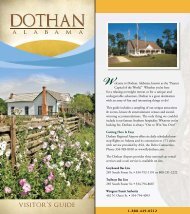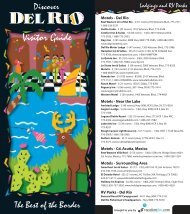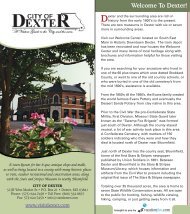PRINT THIS iBROCHURE - VacationFun.com
PRINT THIS iBROCHURE - VacationFun.com
PRINT THIS iBROCHURE - VacationFun.com
Create successful ePaper yourself
Turn your PDF publications into a flip-book with our unique Google optimized e-Paper software.
HISTORY<br />
Our Heritage<br />
Telluride’s First Visitors<br />
The Utes were most likely the first human<br />
travelers to San Miguel Park, the enormous<br />
valley that is now home to the Town of Telluride.<br />
These nomadic people made their summer<br />
camps along the San Miguel River, hunting in<br />
the surrounding mountains and mesas for elk,<br />
deer and Rocky Mountain bighorn. The Utes<br />
retreated to the warmer and drier lowlands in<br />
winter, finding shelter in the canyons of the redrock<br />
deserts. For centuries, their way of life was<br />
unchanged and uninterrupted.<br />
The Explorers<br />
During the late 1700s, while searching for<br />
an overland route from Mexico to their<br />
missions and landholdings in California, Spanish<br />
explorers, led by Franciscan Friars Dominguez<br />
and Escalante, made their way north, crossing<br />
a southern range of the Rocky Mountains that<br />
they named the San Juans. While it’s certain<br />
Spanish prospectors searched for gold and silver<br />
in the mountains near Telluride, they did not<br />
attempt permanent settlement in the region,<br />
leaving only the numerous place names that<br />
bear their distinctive heritage as evidence of<br />
their explorations.<br />
Fur trappers and traders were likely the first<br />
Anglos to spend time in the San Juans, but<br />
when the popularity of top hats made from<br />
beaver pelts decreased, the trappers moved on.<br />
The discovery of gold in 1858 near presentday<br />
Denver put the Colorado Territory on the<br />
map. By the early 1860s, numerous prospecting<br />
parties had made their way to Baker’s Park,<br />
near what is now Silverton. That they occupied<br />
land reserved for the Utes by treaty was of no<br />
concern to them, it seems. Only the advent of<br />
the Civil War deflected—at least temporarily—<br />
these prospectors from the precious object of<br />
their trespass. Following the war, they returned<br />
to the San Juans, and by 1873, with the rush of<br />
gold and silver seekers too great to restrain, the<br />
Brunot Treaty ceded four million acres to the<br />
United States government for an annual annuity<br />
of $25,000. This removed the Utes, once and<br />
for all, from much of their traditional hunting<br />
grounds in southwestern Colorado.<br />
The Prospectors<br />
By most accounts, Linnard (Lon) Remine and<br />
a few fellow prospectors from Kentucky were<br />
the first whites to settle down, albeit illegally,<br />
in the valley during the summer of 1872. In<br />
1874, F.V. Hayden and his U.S.G.S survey<br />
teams mapped and publicized the beauty and<br />
vast potential of the region for eager eastern<br />
U.S. audiences. One year later, John Fallon<br />
reportedly packed out $10,000 in gold ore<br />
from the Sheridan Mine, the richest of his five<br />
registered claims in Marshall Basin. News of the<br />
strike spread, and by 1876 San Miguel Park and<br />
the surrounding hillsides were swarming with<br />
prospectors. San Miguel City arose near the<br />
160-acre Ohio Placer owned by Frank P. Brown,<br />
where Mill Creek joins the San Miguel River.<br />
The town of Columbia was platted a mile and a<br />
half to the east (and closer to the lode mines in<br />
Marshall Basin) in July 1878.<br />
Renaming a Town<br />
Because of potential confusion with another<br />
town of the same name in California, the<br />
Postmaster General refused to grant Columbia<br />
a post office. A name change was in order. To<br />
clarify (or confuse) matters, on July 26, 1880,<br />
the Postmaster General established a post office<br />
called “Telluride” for Columbia. Not until June<br />
4, 1887, was the town officially and forever to<br />
be known as Telluride.<br />
The Mining Boom<br />
For years, the only reasonable access to<br />
Telluride was via Silverton by mule train over<br />
Ophir Pass. Later the Schmek, Dave Wood and<br />
Otto Mears’ toll roads provided oxcart and<br />
wagon access from Ridgway and Montrose.<br />
Otto Mears, the “Pathfinder of the San Juans,”<br />
built his Rio Grande Southern Railroad into<br />
Telluride, arriving on Thanksgiving weekend<br />
in 1890, and a golden age for the town<br />
<strong>com</strong>menced. Immigrants from Finland, Sweden,<br />
Ireland, England, France, Italy, Germany and<br />
China flocked to the Telluride mining district,<br />
swelling the population to some 5,000 souls by<br />
the turn of the century. In addition to its many<br />
saloons, gambling halls and much-heralded<br />
red-light district, Telluride boasted all of the<br />
amenities of a thriving metropolis.<br />
What’s in a Name?<br />
The name “Telluride” probably<br />
derived from “tellurium”<br />
(which, ironically, is not found<br />
here), a nonmetallic element<br />
often associated with rich deposits<br />
of gold. Pre-1877 maps<br />
show a mining camp named<br />
Tellurium in the mountains<br />
northwest of Silverton. Another<br />
theory is that the town was<br />
named for the famous sendoff,<br />
“To-hell-u-ride!,” given to<br />
fortune-seekers heading to the<br />
rugged, rough and avalancheprone<br />
southern San Juans.<br />
20 Telluride & Mountain Village Visitor Guide summer/fall 2009 Make reservations or get information online at www.VisitTelluride.<strong>com</strong><br />
COURTESY TELLURIDE HISTORICAL SOCIETY





